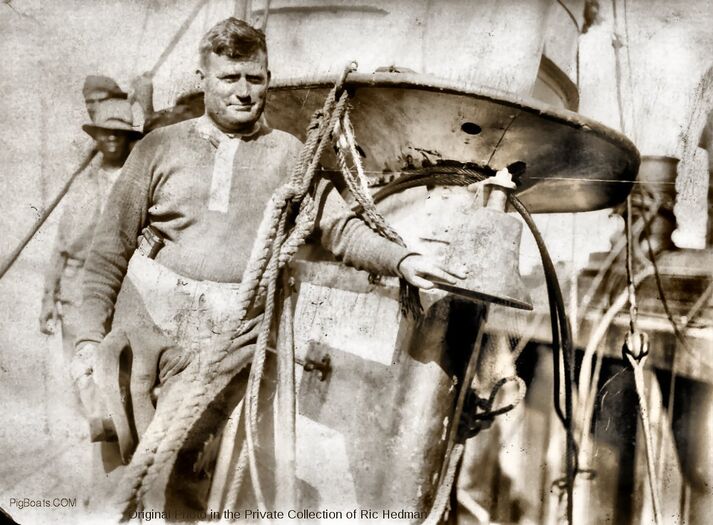O-5 collision: Difference between revisions
Pbcjohnston (talk | contribs) (Added photos) |
Pbcjohnston (talk | contribs) (Added captions) |
||
| (One intermediate revision by the same user not shown) | |||
| Line 2: | Line 2: | ||
[[File:O-5 Abangarez.jpg|left|500px]] | [[File:O-5 Abangarez.jpg|left|500px]] | ||
<div style="text-align: justify;"><span style="color:#00008B"> | <div style="text-align: justify;"><span style="color:#00008B">The Steam Ship Abangarez shown in Panamanian waters approximately 1920. She was owned by the United Fruit Company, a large corporation that dominated the Central American fruit trade. United Fruit would later morph into the well-known Chiquita corporation. | ||
<small> | <small>National Archives photo.</small> | ||
[[File:Red bar sub new.jpg]] | [[File:Red bar sub new.jpg]] | ||
[[File:O-5 mid cross section w bow.jpg|left|500px]] | [[File:O-5 mid cross section w bow.jpg|left|500px]] | ||
This is a cross section of an O-class submarine in the control room. Ric Hedman superimposed an image of the shape of the Abangarez's bow to illustrate how far she penetrated into the pressure hull. The hole was ten feet long and three feet wide and penetrated to a depth of forty inches into the hull. Along with the pressure hull in the control room, the main ballast tank was also damaged, making it impossible for the boat to stay afloat. | |||
<small>Photo in the private collection of Ric Hedman.</small> | |||
[[File:Red bar sub new.jpg]] | |||
[[File:O-5 salvage derrick barge.jpg|left|500px]] | [[File:O-5 salvage derrick barge.jpg|left|500px]] | ||
This is the floating crane barge Ajax, built specifically to lift the huge gates of the Panama Canal locks and one of the largest floating cranes in the world. At the time of the collision, the Ajax was working a land slide in the Culebra Cut in the canal and was on the Pacific side of the slide. Thus she was unable to immediately respond. The dredging work was thrown into high gear and the slide was cleared enough so that the Ajax could be moved to the collision site. Once she got to the site cables were rigged under the bow of the submarine and three attempts were made to lift it to the surface. The first two attempts failed when the cables snapped. The salvage team gained buoyancy by blowing water from the O-5's engine room, and the third attempt was successful. In this photo the bow of the O-5 can just be seen at the waterline below the crane gantry.<br><br> | |||
<small>Photo in the private collection of Ric Hedman.</small> | |||
[[File:Red bar sub new.jpg]] | |||
[[File:O-5 salvage diving crew over.jpg|left|500px]] | [[File:O-5 salvage diving crew over.jpg|left|500px]] | ||
The O-5 operation was a combined effort of both Navy and civilian canal employees. This photo shows a diving boat moored over the wreck site. A diver is preparing to go down the ladder and into the water. The water depth was only 42 feet and it was quite warm so the diver was using a standard Mk 5 diving helmet in shallow water mode, with the helmet and breast plate simply resting on his shoulders with no rubberized diving suit or weights. The helmet can be seen just to the right of the diver on the ladder. Once he was in the water the helmet would be lowered over his head. Further to the right several men are standing around the air pump, ready to man the two large handwheels that would be repeatedly cranked around to provide air for the diver. The boat is moored at the bow of the crane barge Ajax, and there are two other O-class submarines in the background. This was an urgent and somewhat frantic affair, as the men topside knew that there were two men trapped below whose time was running out. | |||
<small>Photo in the private collection of Ric Hedman.</small> | |||
[[File:Red bar sub new.jpg]] | |||
[[File:O-5 salvage 31 hours after sinking.jpg|left|500px]] | [[File:O-5 salvage 31 hours after sinking.jpg|left|500px]] | ||
After 31 hours of intense effort, the bow of the O-5 was lifted to the surface on the third attempt. Brown and Breault are being helped to the small boat alongside, with anxious Navy and civilian personnel standing by to the right and on the Ajax. Submarine chaser SC-285 is standing by in the background. | |||
Lost in the sinking were Clyde Edward Hughes, Motor Machinist's Mate 1st Class; Thomas Theodore Metzler, Fireman 1st Class, and Fred C. Smith, Mess Attendant 1st Class. The bodies of Metzler and Smith were found two days later floating off the Colon breakwater. Hughes' body was never found. Rest in peace shipmates. | |||
<small>U.S. Navy photo.</small> | |||
[[File:Red bar sub new.jpg]] | |||
[[File:O-5 hole made by abangarez.jpg|left|500px]] | [[File:O-5 hole made by abangarez.jpg|left|500px]] | ||
A view of the damage done to O-5 by the Abangarez. One of the liabilities assumed by the submarine force when using a single hull design is that in a collision there is nothing to prevent a breach of the pressure hull. The pressure hull itself is exposed with no outer hull to help protect it. The hole was three feet wide and 10 feet high, penetrating into the control room and the main ballast tanks. This was not survivable damage. | |||
<small>Photo in the private collection of Ric Hedman.</small> | |||
[[File:Red bar sub new.jpg]] | |||
[[File:O-5 ss abangarez cofferdam.jpg|left|500px]] | [[File:O-5 ss abangarez cofferdam.jpg|left|500px]] | ||
[[File:O-5 salvage dockmaster.jpg | Once Breault and Brown had been rescued, the O-5 was fully salvaged and raised from the bottom. In this image the cofferdam can be seen that was built around the hole in the side of the submarine. The hole could not be made watertight, so the cofferdam was used so that the control room could be pumped dry. Bags of what is probably sand can be seen inside the cofferdam, used probably to weigh the wooden structure down so the cofferdam could be fitted around the hole and to the hull. Large hoses attached to big pumps then pumped water out of the cofferdam and the control room. | ||
The person in the foreground is unknown but is undoubtedly a civilian based on the clothing. He is talking to the men in the cofferdam. His hands are resting on the muzzle of the 3"/23 caliber deck gun. | |||
Notice the size of the steel cable in the foreground that is supporting the O-5 to the barge and crane. The "O-5" can be seen easily on the side of the fairwater. | |||
<small>Photo in the private collection of Ric Hedman.</small> | |||
[[File:Red bar sub new.jpg]] | |||
<center> | |||
<gallery mode="packed" widths="450px" heights="350px"> | |||
File:O-5 salvage dockmaster.jpg | |||
File:O-5 salvage dockmaster medal.jpg | |||
</gallery> | |||
</center> | |||
<div style="text-align: justify;"><span style="color:#00008B">The legendary Sheppard J. Shreaves, Dockmaster and foreman shipwright for the Panama Canal Mechanical Division. A bull of a man with immense strength, he was the primary diver during the rescue phase. He spent over 24 hours under water over several dives working diligently to rig the lifting cables under the O-5. He refused to stop until the job was done and his efforts were key in rescuing Breault and Brown. | |||
He was ultimately awarded the Congressional Gold Lifesaving Medal for his work in those 31 desperate hours. The enlisted submarine sailors at the Coco Solo Base presented him with a gold watch in gratitude. | |||
After Beault and Browns' rescue, in Shreaves own account, he says: ''"I was a big hero for a while. The boys carried me around on their shoulders. Everybody rushed down to the Stranger's Club in Colon for a big celebration. But me, I went to sleep at the party."'' | |||
He is seen here standing on the starboard deck of the O-5 after the rescue and once the submarine had finally been brought to the surface. His hand is resting on the O-5 ship's bell. The "5" from the name "O-5" can be seen on the side of the conning tower. | |||
The large cable is one of the many supports holding the cofferdam built around the hole in the hull allowing the vessel to be pumped out. | |||
<small>Photo in the private collection of Ric Hedman.</small> | |||
[[File:Red bar sub new.jpg]] | |||
[[File:O-5 salvage bell.jpg|left|500px]] | [[File:O-5 salvage bell.jpg|left|500px]] | ||
[[File: | A closeup of the O-5 bell. There is no clapper. It was likely removed before the boat left the pier or it was taken off during the salvage operation. | ||
<small>Photo in the private collection of Ric Hedman.</small> | |||
[[File:Red bar sub new.jpg]] | |||
[[File:O-5 Clyde Hughes.jpg|left|500px]] | [[File:O-5 Clyde Hughes.jpg|left|500px]] | ||
Clyde Edward Hughes, one of the men who perished in the O-5 disaster, as seen in a chalk portrait. This image of Hughes is in the possession of John Knight, his grandnephew. | |||
<small>Image courtesy of Charles Hinman of On Eternal Patrol</small> | |||
[[File:Red bar sub new.jpg]] | |||
[[File:O-5 Breault MOH ceremony.jpg|left|500px]] | [[File:O-5 Breault MOH ceremony.jpg|left|500px]] | ||
Torpedoman 2nd Class Henry Breault being awarded the Medal of Honor by President Calvin Coolidge at the White House, March 8, 1924. Breault's utterly selfless action to go back below on the sinking submarine to attempt to save his friend and shipmate was the basis for this prestigious award. Breault stands out as the only enlisted sailor to be awarded the MOH for actions taken aboard a submarine. | |||
<small>Photo NH 52788 courtesy of NHHC.</small> | |||
[[File:Red bar sub new.jpg]] | [[File:Red bar sub new.jpg]] | ||
Latest revision as of 14:34, 5 October 2023

National Archives photo.
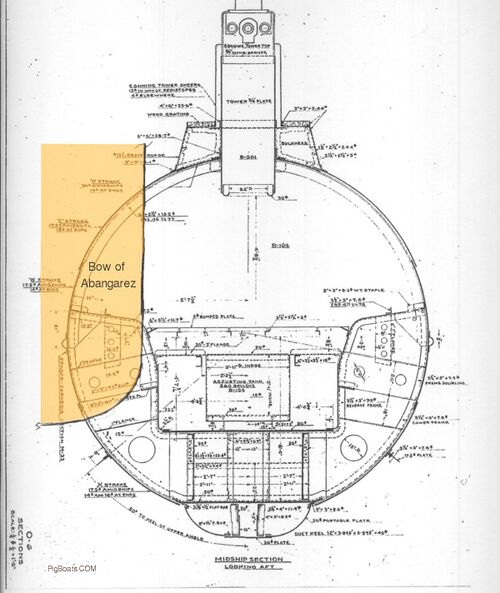
This is a cross section of an O-class submarine in the control room. Ric Hedman superimposed an image of the shape of the Abangarez's bow to illustrate how far she penetrated into the pressure hull. The hole was ten feet long and three feet wide and penetrated to a depth of forty inches into the hull. Along with the pressure hull in the control room, the main ballast tank was also damaged, making it impossible for the boat to stay afloat.
Photo in the private collection of Ric Hedman.

This is the floating crane barge Ajax, built specifically to lift the huge gates of the Panama Canal locks and one of the largest floating cranes in the world. At the time of the collision, the Ajax was working a land slide in the Culebra Cut in the canal and was on the Pacific side of the slide. Thus she was unable to immediately respond. The dredging work was thrown into high gear and the slide was cleared enough so that the Ajax could be moved to the collision site. Once she got to the site cables were rigged under the bow of the submarine and three attempts were made to lift it to the surface. The first two attempts failed when the cables snapped. The salvage team gained buoyancy by blowing water from the O-5's engine room, and the third attempt was successful. In this photo the bow of the O-5 can just be seen at the waterline below the crane gantry.
Photo in the private collection of Ric Hedman.
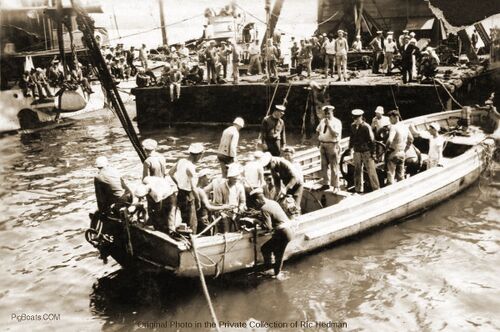
The O-5 operation was a combined effort of both Navy and civilian canal employees. This photo shows a diving boat moored over the wreck site. A diver is preparing to go down the ladder and into the water. The water depth was only 42 feet and it was quite warm so the diver was using a standard Mk 5 diving helmet in shallow water mode, with the helmet and breast plate simply resting on his shoulders with no rubberized diving suit or weights. The helmet can be seen just to the right of the diver on the ladder. Once he was in the water the helmet would be lowered over his head. Further to the right several men are standing around the air pump, ready to man the two large handwheels that would be repeatedly cranked around to provide air for the diver. The boat is moored at the bow of the crane barge Ajax, and there are two other O-class submarines in the background. This was an urgent and somewhat frantic affair, as the men topside knew that there were two men trapped below whose time was running out.
Photo in the private collection of Ric Hedman.

After 31 hours of intense effort, the bow of the O-5 was lifted to the surface on the third attempt. Brown and Breault are being helped to the small boat alongside, with anxious Navy and civilian personnel standing by to the right and on the Ajax. Submarine chaser SC-285 is standing by in the background.
Lost in the sinking were Clyde Edward Hughes, Motor Machinist's Mate 1st Class; Thomas Theodore Metzler, Fireman 1st Class, and Fred C. Smith, Mess Attendant 1st Class. The bodies of Metzler and Smith were found two days later floating off the Colon breakwater. Hughes' body was never found. Rest in peace shipmates.
U.S. Navy photo.

A view of the damage done to O-5 by the Abangarez. One of the liabilities assumed by the submarine force when using a single hull design is that in a collision there is nothing to prevent a breach of the pressure hull. The pressure hull itself is exposed with no outer hull to help protect it. The hole was three feet wide and 10 feet high, penetrating into the control room and the main ballast tanks. This was not survivable damage.
Photo in the private collection of Ric Hedman.

Once Breault and Brown had been rescued, the O-5 was fully salvaged and raised from the bottom. In this image the cofferdam can be seen that was built around the hole in the side of the submarine. The hole could not be made watertight, so the cofferdam was used so that the control room could be pumped dry. Bags of what is probably sand can be seen inside the cofferdam, used probably to weigh the wooden structure down so the cofferdam could be fitted around the hole and to the hull. Large hoses attached to big pumps then pumped water out of the cofferdam and the control room.
The person in the foreground is unknown but is undoubtedly a civilian based on the clothing. He is talking to the men in the cofferdam. His hands are resting on the muzzle of the 3"/23 caliber deck gun.
Notice the size of the steel cable in the foreground that is supporting the O-5 to the barge and crane. The "O-5" can be seen easily on the side of the fairwater.
Photo in the private collection of Ric Hedman.
He was ultimately awarded the Congressional Gold Lifesaving Medal for his work in those 31 desperate hours. The enlisted submarine sailors at the Coco Solo Base presented him with a gold watch in gratitude.
After Beault and Browns' rescue, in Shreaves own account, he says: "I was a big hero for a while. The boys carried me around on their shoulders. Everybody rushed down to the Stranger's Club in Colon for a big celebration. But me, I went to sleep at the party."
He is seen here standing on the starboard deck of the O-5 after the rescue and once the submarine had finally been brought to the surface. His hand is resting on the O-5 ship's bell. The "5" from the name "O-5" can be seen on the side of the conning tower.
The large cable is one of the many supports holding the cofferdam built around the hole in the hull allowing the vessel to be pumped out.
Photo in the private collection of Ric Hedman.
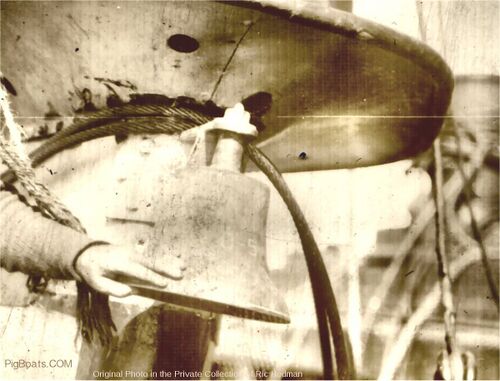
A closeup of the O-5 bell. There is no clapper. It was likely removed before the boat left the pier or it was taken off during the salvage operation.
Photo in the private collection of Ric Hedman.
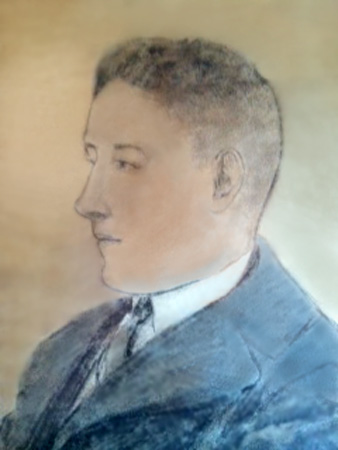
Clyde Edward Hughes, one of the men who perished in the O-5 disaster, as seen in a chalk portrait. This image of Hughes is in the possession of John Knight, his grandnephew.
Image courtesy of Charles Hinman of On Eternal Patrol

Torpedoman 2nd Class Henry Breault being awarded the Medal of Honor by President Calvin Coolidge at the White House, March 8, 1924. Breault's utterly selfless action to go back below on the sinking submarine to attempt to save his friend and shipmate was the basis for this prestigious award. Breault stands out as the only enlisted sailor to be awarded the MOH for actions taken aboard a submarine.
Photo NH 52788 courtesy of NHHC.
Page created by:
Ric Hedman & David Johnston
1999 - 2023 - PigBoats.COM©
Mountlake Terrace, WA, Norfolk, VA
webmaster at pigboats dot com

